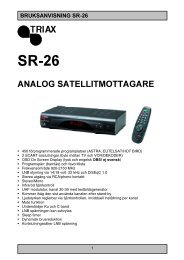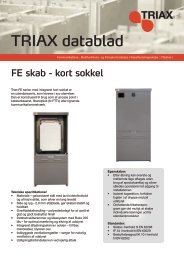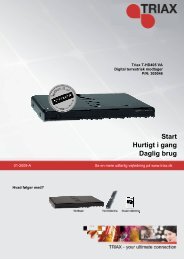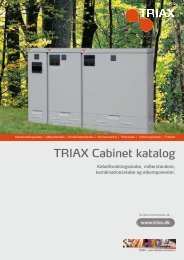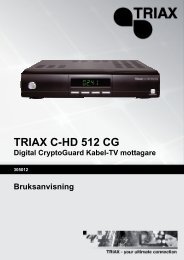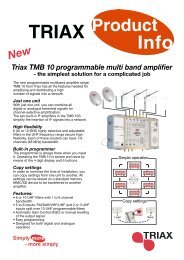TRIAX Multimedia Main Catalogue
TRIAX Multimedia Main Catalogue
TRIAX Multimedia Main Catalogue
Create successful ePaper yourself
Turn your PDF publications into a flip-book with our unique Google optimized e-Paper software.
Technical appendix<br />
3. Planning and installation instructions<br />
- continued from last page<br />
3.4. Signal-to-noise ratio, noise factor<br />
If the frequency band contains only one half of the number<br />
of channels (with constant channel spacing), it is possible to<br />
raise the output level by 3 dB. If the configuration lies<br />
somewhere in between these extremes, it is possible to make<br />
a rough interpolation.<br />
c) Maximum output level for frequency<br />
pre-compensation (line equalizer)<br />
A frequency pre-compensation value for example of 10 dB<br />
using a line equalizer permits driving the amplifier approximately<br />
2 dB higher. This value can also be treated as output reserve.<br />
It should be noted, however, that the signal-to-interference<br />
ratio at low frequencies will deteriorate by the amount of the<br />
compensation attenu ation. For extreme cases optimization by<br />
a planning specialist is therefore required.<br />
d) Permissible output level when cascading amplifiers<br />
For cascades, reduce the output level by 3 dB each time you<br />
double the number of cascaded amplifiers.<br />
3.2. Radiated interference power and<br />
max. operating level<br />
The radiated interference power of an antenna system<br />
according to EN 50083-2 may not exceed:<br />
• 20 dB(pW) = 39 dB(µV) at 75W in the frequency range<br />
30-950 MHz<br />
• 43 dB(pW) = 62 dB(µV) at 75W in the frequency range<br />
950-2500 MHz<br />
Thus, in conjunction with the shielding rate specified for the<br />
equipment, the maximum operating level is as follows:<br />
Maximum operating level =<br />
• Shielding rate + 39 dB(µV)<br />
(in the 30-950 MHz frequency range)<br />
• Shielding rate + 62 dB(µV)<br />
(in the 950-2500 MHz frequency range)<br />
3.3. Shielding rate<br />
The passive Triax components in this catalog meet as a<br />
minimum the shielding rates required by EN 50083-2, class B:<br />
• 5-470 MHz 75 dB min<br />
• 470-950 MHz 65 dB min<br />
• 950-3000 MHz 50 dB min<br />
Class A components meet the increased requirements of<br />
EN 50083-2<br />
• 5-300 MHz 85 dB min<br />
• 300-470 MHz 80 dB min<br />
• 470-950 MHz 75 dB min<br />
• 950-3000 MHz 55 dB min<br />
The signal-to-noise ratio is the ratio of the used signal power<br />
to the noise power expressed in decibels. The noise factor<br />
defines by how much the signal-to noise ratio at the output of<br />
an active unit (e. g. amplifier) is less than the signal-to-noise<br />
ratio at the input.<br />
The thermal noise level on a 75 W resistor amounts<br />
- for a bandwidth of 5 MHz (TV channel) and<br />
- for a temperature of 293 K to approximately 2 dB(µV).<br />
The signal-to-noise ratio of the received signal is the decisive<br />
factor for the video quality of a TV set (see below).<br />
The signal-to-noise ratio at the output of an individual amplifier<br />
(for ideal, i.e. noise-free input signal) can be determined as<br />
follows:<br />
Operating level at the output<br />
– gain<br />
– noise factor<br />
– noise level<br />
Example:<br />
An amplifier with the following output parameters:<br />
94 dB(µV) operating level, 21 dB gain, and 7 dB noise factor.<br />
The signal-to-noise ratio at the output of an<br />
individual amplifier would then be:<br />
94 dBµV<br />
– 21 dB<br />
– 7 dB<br />
– 2 dBµV<br />
64 dB<br />
3.5. Signal-to-noise ratio, noise,<br />
picture quality<br />
Signal-to-noise Noise<br />
Picture quality<br />
ratio<br />
> 46 dB invisible very good<br />
37 dB visible,<br />
good<br />
but not interfering<br />
30 dB clearly visible, unsatisfactory<br />
interfering<br />
< 26 dB dominant compared<br />
to required signal<br />
unusable<br />
For active units, the class A marking<br />
also documents compliance with<br />
EN 50083-2.<br />
251




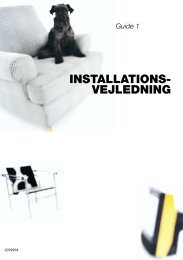
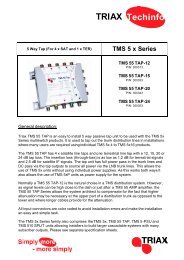

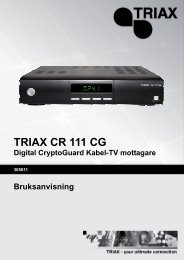
![Triax product info - DVB-C modul TDH [DK - GB].indd](https://img.yumpu.com/48426483/1/184x260/triax-product-info-dvb-c-modul-tdh-dk-gbindd.jpg?quality=85)
